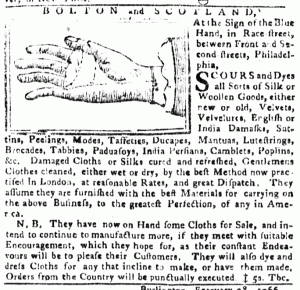What was advertised in a colonial newspaper 250 years ago today?

“BOLTON and SCOTLAND, At the Sign of the Blue Hand.”
As soon as I saw this advertisement I knew that I had to select it. It didn’t matter what it said, only that it included a visual image, a woodcut of a (presumably blue) hand that likely replicated the “Sign of the Blue Hand” where Bolton and Scotland operated their business “in Race-street, between Front and Second-streets, Philadelphia.”
Most newspaper advertisements for goods and services did not include images of any sort during the eighteenth century. Unlike type that could be used repeatedly and for any purpose (set, broken up, and reset for a new job), images were often very specific to a particular advertiser’s business. This image of a hand would not have worked for any advertiser who did not happen to run a business “At the Sign of the Blue Hand.”
This is not to say that other kinds of advertisements were devoid of images. Printers usually had a small selection of woodcuts, especially ships, houses, and runaway slaves, that could be used interchangeably and generically in advertisements for vessels preparing to leave port, real estate, or seeking the return of runaways.
Shopkeepers, artisans, and merchants who wanted to spruce up their advertisements, however, had to commission their own woodcuts, but then those woodcuts belonged exclusively to them and did not appear in other advertisements. This may be obvious when looking at the Blue Hand, but it is worth keeping in mind that it applied to other sorts of woodcuts associated with particular shops. For instance, a woodcut of a spinning wheel that accompanied John Kean’s advertisements was used exclusively in his advertisements – as a brand of sorts – and was not inserted in other advertisements for textiles.
Today we are accustomed to advertisements that include stimulating visual images. In the eighteenth century, however, advertisements were typically comprised mostly of text. Images were an exception rather than the rule.
